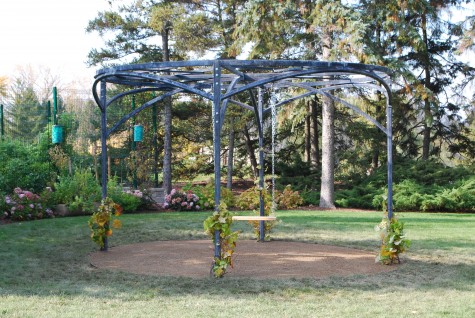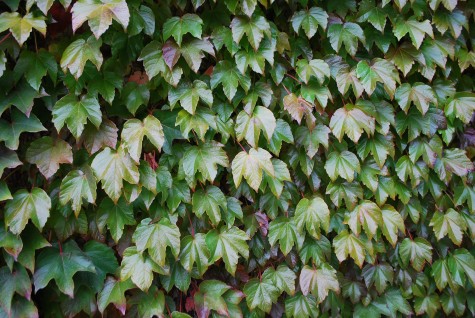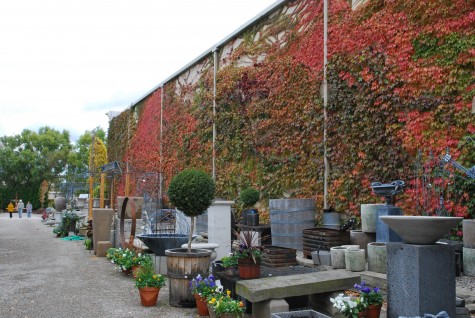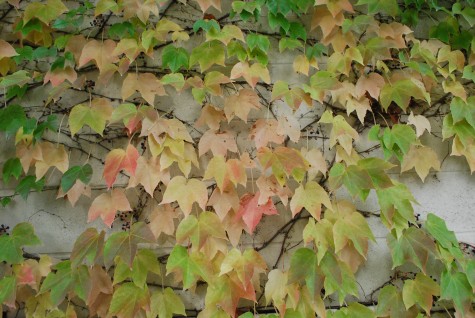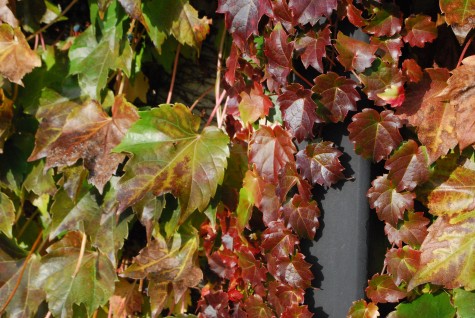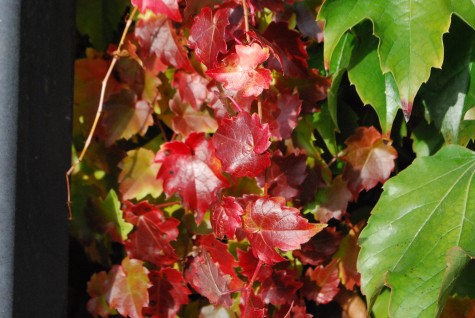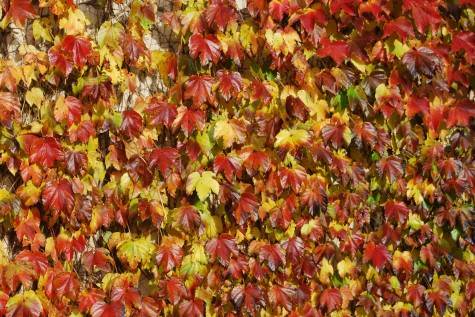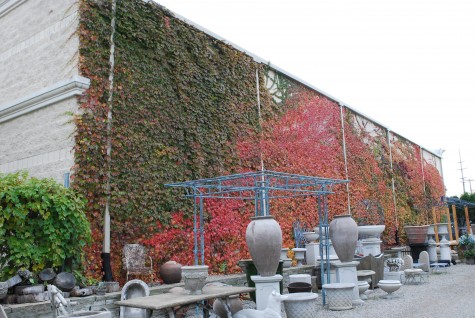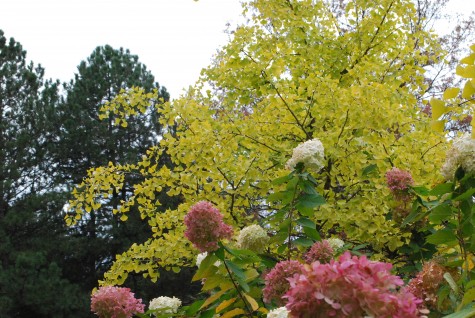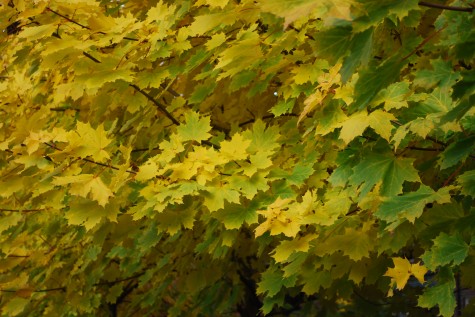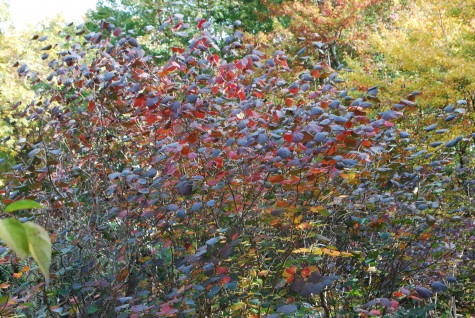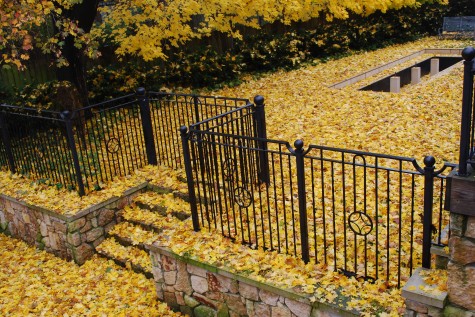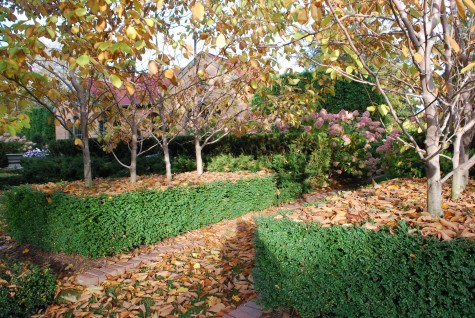
Lots of plants climb-all of them climb in different ways, but they all do the big job of providing interest when the planting space is small. Climbers are of great value in the garden; they take up little space on the ground plane, and go on to generously represent high off the ground. A small garden, a small space, a small garden space needing some live activity up high-climbing plants may be just what you need. Some climbing plants that need a supporting structure are incredibly strong and vigorous-grapes fall into this category.
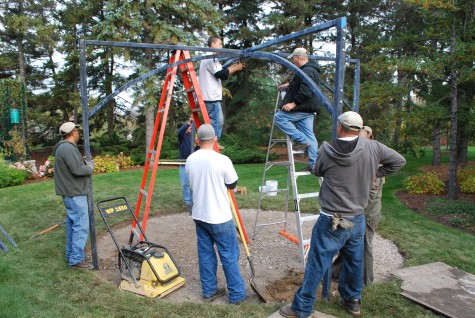 A client interested in a pergola that would support grape vines, and a swing she might enjoy with a grandchild informed the design. An overall diameter of 14 feet would be proportional to the space. Buck felt that a design based on curves would provide the greatest strength.
A client interested in a pergola that would support grape vines, and a swing she might enjoy with a grandchild informed the design. An overall diameter of 14 feet would be proportional to the space. Buck felt that a design based on curves would provide the greatest strength.
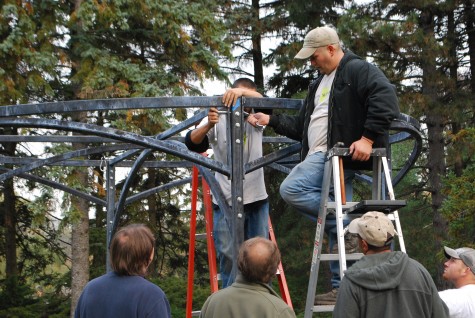 Any gardener who has ever grown a vigorous but lax vine requiring support knows the heartache. Big strong vines can crush a light duty trellis in no time. Wisteria, grapes and trumpet vine require serious support. A lax vine has no natural mechanism by which it attaches itself to a vertical surface. Clematis and climbing roses need a trellis to support their skyward growth. Though wisteria and grapes have tendrils quite capable of a good grip, they need some physical encouragement to get up and off the ground.
Any gardener who has ever grown a vigorous but lax vine requiring support knows the heartache. Big strong vines can crush a light duty trellis in no time. Wisteria, grapes and trumpet vine require serious support. A lax vine has no natural mechanism by which it attaches itself to a vertical surface. Clematis and climbing roses need a trellis to support their skyward growth. Though wisteria and grapes have tendrils quite capable of a good grip, they need some physical encouragement to get up and off the ground.
 Once they are up and off the ground, grapes grow with a vengeance. They need a very strong structure to support them. I like steel in this application; there will be no need for paint or any other maintenance once the vines get large. The circular shape fit fine in a small area near the vegetable garden.
Once they are up and off the ground, grapes grow with a vengeance. They need a very strong structure to support them. I like steel in this application; there will be no need for paint or any other maintenance once the vines get large. The circular shape fit fine in a small area near the vegetable garden.
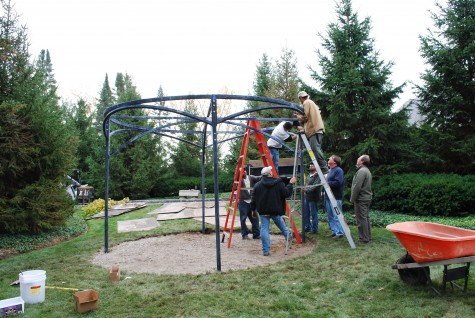 For the most part, Buck fabricated this pergola up side down. This enabled him to work more easily with incredibly heavy pieces of steel. Amazingly, he fabricates these large structures all on his own. The installation today involved bolting together some 21 pieces of steel fabricated in the studio. Level, square, plumb and true works well in the lab. In the field, it takes a lot of people, and a lot of moving up and down, and side to side-to get the pergola back to level and plumb.
For the most part, Buck fabricated this pergola up side down. This enabled him to work more easily with incredibly heavy pieces of steel. Amazingly, he fabricates these large structures all on his own. The installation today involved bolting together some 21 pieces of steel fabricated in the studio. Level, square, plumb and true works well in the lab. In the field, it takes a lot of people, and a lot of moving up and down, and side to side-to get the pergola back to level and plumb. 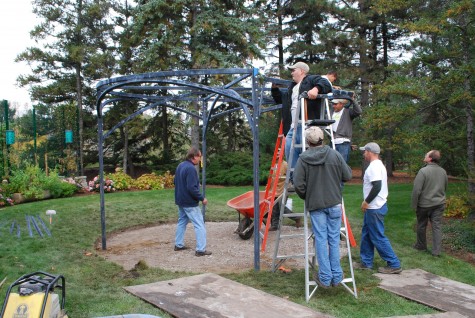 <
<
All of the side trusses were put up with a single bolt and nut. Once every side truss was in place, a single long bolt that would secure 2 trusses at a time replaced the single temporary installation bolts.  Buck routinely assembles an installation kit for his big projects. Steve indicated he wanted Buck to attend this installation-he did. Every piece of steel has a label. He did a sketch detailing the order of events, the assembly of the poles and trusses, and the roof members.
Buck routinely assembles an installation kit for his big projects. Steve indicated he wanted Buck to attend this installation-he did. Every piece of steel has a label. He did a sketch detailing the order of events, the assembly of the poles and trusses, and the roof members.
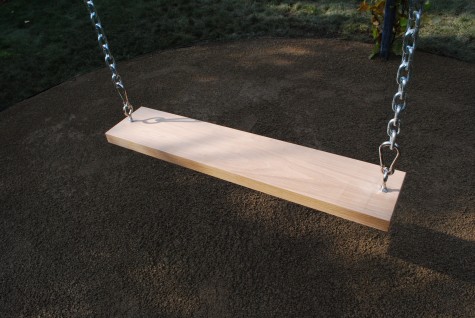 My client was pleased. She greatly appreciated the architectural appearance of the pergola. When I know I have grapes to sustain, I go for serious architecture. The Boston Ivy clings to walls all on its own. Climbing hydrangea is slow and pokey to take hold; all I have to do is wait. Climbing roses do not need anything all that strong; they just need whatever you are willing to give. Trumpet vine-research this before you plant-it is a thug of a plant. The sweet autumn clematis will work with you. Ancient ivy climbs whatever is within its range. The climbing plants-I am sure you are familiar with their demands. A pergola strong enough to get grapes aloft and keep them there-I left that to Buck.
My client was pleased. She greatly appreciated the architectural appearance of the pergola. When I know I have grapes to sustain, I go for serious architecture. The Boston Ivy clings to walls all on its own. Climbing hydrangea is slow and pokey to take hold; all I have to do is wait. Climbing roses do not need anything all that strong; they just need whatever you are willing to give. Trumpet vine-research this before you plant-it is a thug of a plant. The sweet autumn clematis will work with you. Ancient ivy climbs whatever is within its range. The climbing plants-I am sure you are familiar with their demands. A pergola strong enough to get grapes aloft and keep them there-I left that to Buck.
